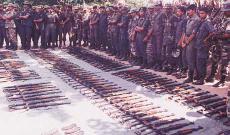


 Battle
and the booty..but there were setbacks too
Battle
and the booty..but there were setbacks too
The army has scored one
over the LTTE by being honest with the press about the situation in Kilinochchi
and the forward areas of Operation Jaya Sikurui.
A clearer picture of the theatre of operations between Vavuniya and Mankulam has emerged now beyond any reasonable doubt. The Kilinochchi scene remains somewhat ambiguous despite the bold effort made by the army to show journalists part of that town.
The situation is far from rosy here. By the army's own admission the Tigers have captured and are holding on to more than six square kilometres of the once sprawling base which was almost impregnable with its 10 foot concrete bunkers. This is the case, although a series of mishaps had prevented the LTTE from carrying out the assault as planned. One main battle tank got stuck off the road on the way to Kilinochchi due to a mechanical problem and an armoured personnel carrier which was sent to help pull it to safety burst a pipe. LTTE units which were waiting to move with these vehicles had to change plans as a result.
Then the LTTE field commanders had to evacuate a large number of cadres from a key point of the assault when the South African Buffle with the 800 kgs of high explosives turned over before reaching it target. Later a field hospital of the Tigers was hit by a Kfir bomb, killing more than forty wounded cadres and four doctors.
The point which is missed in the jubilant descriptions of the LTTE's failure to completely overrun Kilinochchi and Paranthan is that the LTTE, given sufficient time and resources, does not take long to build and perfect on its experience. The military development of LTTE after its attack on the Elephant Pass camp in 1991 is a case in point. The camp was held by a battalion of soldiers. The Tigers attacked and laid siege for almost a month, losing 600 cadres in the process, and still could not overrun the camp. But just two years later they took on the brigade size Pooneryn base and its naval facilities, in a complexly coordinated amphibious operation. Then came the swift Mandaithivu operation in which the Tigers overwhelmed the camp with very minimum losses.
Hence, the inability of the LTTE to overrun Kilinochchi and Paranthan has to be seen as the basis for the next phase in the LTTE's military growth. However, this time this is subject to some conditions which the LTTE leadership didn't have to reckon with in the past.
The possibility of developing the Kilinochchi experience into advanced military capability, depends very much on the potential of the LTTE to sustain its current conventional strength in the Wanni. This potential has come under serious threat for the first time since 1990 with the advances made by operation Jaya sikurui. The LTTE needs revenue, manpower and adequate terrain to train, camp and maintain a sophisticated fighting force that can undertake operations on the scale of the Kilinochchi-Paranthan assault. The Tigers can continue without much hindrance to get ample funds from Jaffna, the eastern province and the west. Recruitment will be high as long as the army continues to be harsh on the Tamils of the east. The third factor an adequate area under the LTTE's control to train, camp and maintain a sophisticated fighting force looks precarious now, although the possibilities in this respect have not been completely exhausted. The LTTE's current strategy of slowly allowing the army to spread itself into the centre of the Wanni is, from one perspective, a gamble.
Why ?
For this strategy to work, the LTTE must sustain and, with some luck, enhance its conventional capability so that it can continue with large scale counter attacks on the Jaya Sikurui troops spread thin on the ground on either side of the A9, nullifying thereby, the army's ability to launch operations in the eastern and western interior of the Wanni to debilitate the current military potential of the Tigers.
The army is now approaching the vital Vannivilankulam junction which is to the west of Mankulam on the road to Mallavi and Thunukkai which together form the administrative and functional heart of civilian life in the Wanni today.
Foreign NGO's that keep the region going are mostly based here. The UNHCR was planning to shift its offices in Vadakaadu which is not far from Wannivilankulam in the direction of Mallavi last month, worried that the village might come within the artillery range of the army soon.
If the army consolidates its position in Wannivilankulam and advances either side towards Mankulam and Mallavi, running the Wanni the way the LTTE would ideally want to might become difficult. Of course, the LTTE has places like Mulankavil more to the west where the administrative based of the region can be shifted. (The plan to build Mullaithivu town as the centre failed due to logistical problems when the army cut off all main access routes between the eastern and western parts of the Wanni)
In this sense, the strategy of Jaya Sikurui is also a gamble. That is, if the LTTE retains its conventional strength, developing and honing it further on the basis of the Kilinochchi-Paranthan experience, while Jaya Sikurui has spread three divisions thin, on either side of the A9, then the army's longest operation might find itself stuck in a deadly quagmire. (It is for this purpose that the LTTE uses more of mortars than manpower to slow Jaya Sikurui).
Here, it will not matter whether the army is on the verge of opening the road. Instead the point will be whether the LTTE can pin down the three divisions to the job of fighting to gain more kilometres of the highway until the next monsoon.
Return to the Editorial/Opinion contents page
